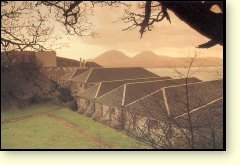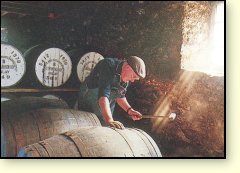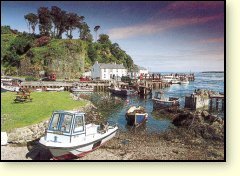
 |
|
Location: Port Askaig, Isle of Islay PA46 7RP
Hours: 10am - 4pm Mon - Fri
All visits by appointment
Group bookings max 12
Reception centre and shop
Phone: 01496-840646
|
Text from The Whisky Trails, Copyright © Gordon Brown 1993:
The sleeve of water that separates Islay from Jura to the east begins to widen out where the little distilling outpost of Bunnahabhain sits on the shore. The boat you see apparently waiting to unload malt has, in fact, been there since 1974 when it was cast on to the rocks. The distillery sits mainly to one side of the pier and climbs the hillside part of the way. Houses on harbour front and hillside take up the other side of the pier and sheep wander everywhere just as cats do in mainland suburbs.

A cooper at work, renovating barrels ready for the maturing process at Bunnahabhain.
|
There was a time when tourists bought Bunnahabhain (‘Boon-a-havn’) for all the wrong reasons. Funny, unpronounceable names often attract attention but this one also happens to be the top-selling brand, malt or blend, at the Scotch Whisky Heritage Centre in Edinburgh. It is one of Islay’s gentle malts and quietly enjoying its status as a malt to be ‘discovered’. Bunnahabhain features in the Famous Grouse Scotch blend which is owned by the distillery’s proprietors.
Bunnahabhain was established in 1881 – the same year as Bruichladdich – and for the same reason – to meet the growing demand for whisky for the blending industry – but materialised at the isolated opposite end of the island, beyond even remote Caol Ila. This was probably because blending company Robertson & Baxter particularly liked Caol Ila’s whisky and set out to produce their own in the same style by building close by. The proprietors even had to build their own road just to get things started; houses and food-stores for the distillery workers and a school for their children followed. Bunnahabhain became a fine example of the self-sufficient distilling communities that had grown up all over Scotland. Alfred Barnard, who toured Scottish distilleries in the 1880s, described Bunnahabhain, as a ‘life-like and civilised colony’. The name means ‘river-mouth’, referring to the River Margadale alongside.
The malt whiskies produced on Islay are generally thought to be peaty, pungent and seaweedy. But since 1883 Bunnahabhain has been creating a fine mellow whisky that is one of the smoothest and subtlest of the island’s malts.
Just a few years after its construction, Bunnahabhain’s owners joined up with two other distilling firms to form Highland Distilleries and to this day they remain the proprietors. The distillery closed for a short period in the early 1980s but has since reopened, its production apparently secure at least for the present. With a name the length of ‘Bunnahabhain Distillery’ it would not be surprising if the two warehouses at the water’s edge which bear the words were deliberately built long enough to carry all the letters. A single pair of stills was augmented by a second pair in 1963.
The Whisky
Text from The Whisky Trails, Copyright © Gordon Brown 1993:
Bunnahabhain is a soft, light malt at least partly due to the natural lack of peat in the water and light peating. This change from the heavily peaty style of the past has come about by the distillery’s trapping spring water in the hills to avoid its running through the peat-beds. The whisky tends also to show floral and fruity tones, everything coming over with considerable subtlety. The ‘middle cut’ of each distillation run is said to be particularly small and a proportion of sherry casks is used for maturing the spirit. Twelve years and 40% or 43% vol. is customary and variations from independents are few and far between, though vintages from 1982 and 1979 at high strengths have cropped up recently.
Source of water
Springs near the
Of interest
Text from The Whisky Trails, Copyright © Gordon Brown 1993:

From Port Askaig on the sound of Islay it is only a very short distance to the Isle of Jura.
|
• The Parliament of the 14th-century independent Gaelic principality run by the Lords of the Isles was located in the stronghold on the island in Loch Finlaggan. New chiefs were proclaimed from there and treaties with foreign governments against the Scottish crown were ratified there. There are several carved stones on the island.
• The Museum of Islay Life at Port Charlotte gives a good perspective on the islanders’ lifestyles over the centuries in their main occupations of farming, fishing and distilling. Among the exhibits is an illicit still that was used in the hills nearby over a long period of time.
• The Cross of Kildalton is eighth-century Celtic, yet in fine condition. There was much activity in these parts in establishing Christianity; Iona, place of pilgrimage where St. Columba is thought to have first landed, is close by.
• The Oa Peninsula, which makes up the south-western section of the island, was used by smugglers due to the large number of caves there. Spectacular cliffscapes give it a wild aspect with views in all directions.
• Have a dip in the Bowmore Distillery Swimming Pool, heated by waste-waters from the distillation runs.